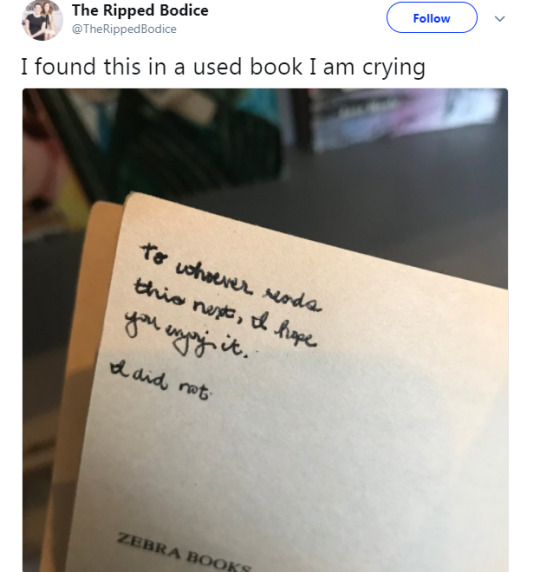Don't wanna be here? Send us removal request.
Text
Reflections
We started out with a board game, and ended up with site-specific interactive art. We started out with houseplants, and ended up with pants as urban citizens.
Well, to be fair, we started out with “what???” and ended up with “what if?”
To be completely honest, I never thought of the city being more than a human construct. Dolphins live in pods, sheep live in herds, and humans live in apartments. We built these landscapes and if pigeons and rats and other creatures live here too, they’re tag-a-longs. If the coyotes in the city thrive, then that’s on their own power, if the weeds grow through the sidewalks, then that’s just nature’s resilience.
Culturally, I sort of lean towards respecting the spirits of nature, but the average tree didn’t strike me as something to think about. But after doing all this research on plants, on their communications and their social communities, I find it hard to understand why we shouldn’t consider them as well when designing for a more sustainable and harmonious future.
Around the same time that we were beginning to developing our initial plant game, I heard that Tatiana was experimenting with DIY growing plants for her group’s project. I offered her the butt of some celery I was going to toss, and put it in some water to keep until I gave it to her. I didn’t expect anything to come of it.

Within two days a thin root had emerged, and within a few weeks it was a real plant, with leaves and everything! It was kind of weird to think about how it just started growing. Just add water! BAM, life!
It was supposed to be temporary custody, but due to the lock-down the celery stayed with me. I fiddled with it daily, changing water and moving its little sauce container between sunny spots in my room and breathing on it. (I have no idea how plants work.)
I thought of going to find some soil for it, when it started getting too old, but then the spots came and it began to rot and smell and then it was time to say goodbye.
For those few weeks, it felt good to care for something, and moreover, it was startlingly apparent how alive the plant was. Maybe I’m assigning human perspective again (because really, how can I not?) but it felt like it really wanted to live, even if the circumstances were not ideal. And I find that I can sympathize.
I don’t see why we can’t help plants along when we could design for both of us to live together in the city. Not saying that I will respect the life of something like giant hogweed that will harm people (and here’s where I guess now we get into the why do humans get to decide the world conversation) but it seems like the current attitude of subjugating other creatures for human gain does not have to be the way we continue.
In the end, we’re being cultivated as plant-food anyway.
0 notes
Text
Bad Neighbors
Thinking about the tree that owns itself: https://www.atlasobscura.com/places/tree-owns-itself
After the crit, our group’s been talking about the agency of plants a lot more. To be completely honest, I’m a little worried about how far we’re wandering from the space of “repurposing” and sharing, especially so late in the game. But this is exciting, uncharted territory, and if we’re taking a risk in how we’re moving more and more to plants as equal citizens of urban environments, then I guess so be it.
At first I was thinking a lot about foraging, and the way that plants exist almost invisibly unless suddenly I’m looking for something in particular. I went on a walk months ago with my flatmate and she just casually started eating the bursting blackberries along the path. I was a bit freaked out at the time, and a little envious.
Now we’re talking about trees and greenery within transitional spaces. Trees, they’re impacted by the way humans shape our environment. Underground parking garages limit the root system of trees that we’d want to plant. When they get too big, trees are removed for the structural integrity of our buildings.
What if every tree owned itself like the one in Georgia?
"I took my neighbor to court last week.” “Oh yeah, what happened?” “Nothing! His tree’s been creeping over onto my front yard and dropping their trash everywhere. And the judge thought it was fine!” “God, weird, really? Didn’t that guy down the street get sued for leaving dog’s poo everywhere? If you can’t take care of your tree you shouldn’t have one!” “Yeah! Exactly what I thought! But my neighbor said he’s a hostage of the tree too. His dad raised it when he was young and now it’s trying to take over the family property and everything.” “Oh that sucks...” “Yeah, judge thought he had enough on his hands with trying to move the house a meter to the left.”
I almost can’t imagine it.
The benefit of this kind of world, though, would be that a book like the Giving Tree wouldn’t exist. I hate that book, ever since I had to read it as a child.

It’s about a tree that gives and gives while the humans take and take. I’m not sure what the book was really trying to say except if you’re a pushover you get stomped. The tree in that book was happy to give more and more, and it’s also about the life cycle of this specific tree. But to me, it sounded like the human voice sugar-coating the traumatic experiences of the tree.

Another struggle that our group has had is how to understand trees--there is no way we can untangle ourselves from our human perspective, and to assign personification to trees seems to be missing the point. Plants are happy, sure, under the right circumstances, and they make decisions based on chemical signals in a way that could be mistaken for thought, but what do they desire? How does agency differ from natural progression (if I continue to live and breathe, I continue to age regardless)? Or am I too human again in making that distinction?
Maybe the core of our project is just coexistence. Not to change, not to affect, but to be, exactly as we are now, only more aware of the plants around us in our urban environments.
When this is all over, I’ll visit the copse at Highbury & Islington for the first time and give a tree a hug.
0 notes
Video
tumblr
Oops before I forget, here’s that video I made about clothes...
hahahaha _(:3」∠)_
If we’re personifying, we might as well go all the way, right?
When writing this, I had to go back to my clothes persona and the interviews and think about what I wanted to highlight. The first idea I came up with was a interview style sad-sappy monologue. But that was too depressing and not entertaining; felt too unsubtle.
But then if there is one such person-shirt, there must be more, right? So it’s more fun when characters talk to each other. Writing the dialog was hard, because what would shirts even talk to each other about? What personalities would they have?
Making the video made me think about camera angles, and conversations, and how awkward it would be to see all your neighbors get tossed and sort of know the possibility of your own mortality. In this universe, these shirts might not know what the afterlife entails, only that there is an end and the end comes. Maybe we can say the sweater will get recycled or it will get passed down or it will get repurposed, but who knows? Certainly not the shirt’s brethren...
Originally I had thought about making something more serious, more informative, but... Some of my favorite videos are commercial shorts; I think it’s such a effective vehicle for public art and a capsule for the social values of the day. The most interesting ones tell stories, or use a smart concept, instead of specifically promoting or stating a position. I loved Superflux’s Uninvited Guests, how it shows human relationships with realistic characters and without making a point outright.
One of my favorite commercials, which I saw years ago, is this Mercedes Benz commercial. It only shows chicken but the concept is so clear! (Yes I have a list.)
youtube
0 notes
Text
Plants + Games!
Yay! Direction! I’m so excited.
I feel like the group’s been talking a lot about storytelling games, the games that prompt people to think and spitball. But I wonder if there’s a better vehicle?
Off the top of my head, there’s all these variations in board games, all suited for different stories + lessons. (These categories aren’t mutually exclusive, and don’t even have similar functions or orders of magnitude, it’s more like a vomit of game mechanics so I can remember what to think about.)
cooperative (work together for mutual benefit, e.g. the beginning of Haunting of House on the Hill, fighting together against a boss)
competitive (self explanatory, e.g. monopoly, the end of Haunting of House on the Hill, Dixit)
stealth (lying and figuring out the liar, e.g. Avalon, mafia)
intelligence (better to have the book smarts, e.g. chess, scrabble)
strategy (planning and weighing options, e.g. poker, uno, monopoly)
luck (planning only gets you so far, e.g. battleship, I declare war, candyland)
map (drawing or uncovering a map is important, e.g. quiet year, Catan, Risk)
storytelling (building on top of what’s already been said, e.g. quiet year, each person adding a word to the story)
social games (using the existing relationships within the group, e.g. cards against humanity, charades, catchphrase)
physical objects (you need the object to play the game, e.g. barrel of monkeys, hungry hungry hippos)
party games (less board-anchored and lots of people, e.g. pin the tail, red light green light, hide and seek)
The most memorable and interesting game sessions, in my opinion, happen when the mechanics match and enable the narrative.
For example, in Risk when alliances backstab each other, or in Avalon when your trusted compatriot turns out to be an enemy. The mechanics allow the player to make choices that help tell an interesting story, and often a story that emulates real life.
On the other hand, I love exploration within games. When there is genuine excitement in our shared map during the Quiet Year, or when you discover a creepily perfect cursed item when you enter a room in House on the Hill.
So, I guess I’m interested in a developing a game with *conflict* and/or *exploration*
Now, what’s the narrative?
Now that we’ve all decided to focus on the circular economy as applied to plants, I feel a little like I have to relearn everything.
Nevertheless, Lara had the great suggestion of seeing if themes applied across our different domains.
In transplanting some themes from my original focus, clothes, we have:
- challenges re:trust (”how do I know where it’s been?” // hygiene concerns) - the cost of new clothes (low barrier for some people // high sustainability-wise) - opportunity costs re:storage (spring cleaning, hoarding, having too many) - the difficulty/ease of maintaining what we already have - the appeal of newness (and staying on trend, staying fashionable) - knowing who to give/get something second-hand
Looking at Annie’s plant persona... initial ideas are:
trust - if I’m giving away my plant/I am the plant, how do I know if someone will maximize lifespan? and is this lifespan of a living plant or the plant as an object/resource? could be a quiz game and whoever knows the most gets points...
as a perennial, I can “die” and come back, so in a way there is a way to get more of me... what about a GHOST STORY? what if you die as a plant and then get reborn as something else but you continue to bloom when the time comes? this could be destructive to humans but also a way to help humans with their life problems? blooms take effort to grow, but maybe when conditions are fulfilled you can bloom and go to the next lifecycle?
Or like lemonade tycoon? you want to compete for the map/territory/flower shop, or you want to compete with other flowers to have as many copies of yourself as possible?
sort of an invasion type game, except you invade living rooms, parks, etc. in different kinds of matter (tea, flower, vitamins, medicine, etc.). Maybe you’re a plant scientist that wants to popularize your creation
what if you’re all plants competing for attention, and depending on the cards you draw, the attention of your gardener changes? strategy game
what if it’s a strategy game but you’re the gardener and you want to maximize your garden. You get points for card combos that maximize use of plant (born, discard, seed, etc.) and you win when you hit a certain number of points first. Sort of a la Photosynthesis.
or what if you’re all gardeners trying to nurture pageant flowers and make it like a Miss America for flowers (re:Chelsea Flower Show)
cuttings vs. main body - I’m seeing something like plants vs. zombies now
or maybe a cooperative game about people sharing plants across the city? work together to make a city bloom... ideally cooperation across groups would be good... but how do you make an interesting game of it?
Social, psychological and civic problems around sharing plants?
The logistical elements of getting plants around, probably, and that it’s so easy to throw out and so hard to maintain...
Important part of city life?
There are some fancy flower shows but there are also a lot of florists, and mid-sized supermarkets all have flowers here in London, and what’s odder, people actually buy these flowers. In NYC I don’t think people really went to the florist unless for special occasions.
If there’s a way to work parts of daily life into this, I think the narrative would be stronger and the game would be more meaningful...
What is the world that we want to live in?
I don’t know yet... but one that doesn’t waste the plants, and understands that these are both living beings and a useful resource.
Ideas:
Plants competing in an apartment for resources. Card game where you draw cards/play cards to react to effects and events (get moved to best spot, steal 2 cards from neighbor)

Sailor Moon inspired transformation game where you transform plants to fight monsters like a bad smell or not enough sunlight or food that needs seasoning. Sunlight determines actions available per turn

0 notes
Text
Hi my name is: Blue Uniqlo Jumper

We’ve decided to make personas and map journeys for a specific object that we got to know through this process. Through a mixture of the interviews, observations, and desk research, here’s my friend Blue Uniqlo Jumper.
It’s surprising how easily I can personify the sweater, give it dreams and hopes and challenges. I know the persona isn’t supposed to be “if I was this person, how would I think?” And this isn’t completely that--I’ve pulled together details from interviews we’ve conducted--but there is my underlying bias towards sustainability, so the sweater’s longing for a long life.

There’s a whole genre of stories of ghosts or spirits that possess objects. Ghost stories pop out of chairs, hairclips, dresses, guns, TVs, VHS tapes, bones. In the more neutral sense, prolonged handling of an item leaves some residue, a bit of humanity. I feel a little like I’m writing a similar possession story for this sweater, but instead of a specific person, the sweater has its own character. (Maybe I should give it some hobbies...)

It was really helpful to draw out a chart too to organize the places that the sweater could come from or go to. Some of them end in reincarnation as a new object, such as cotton into insulation, and sometimes the sweater continues aging in its present form. If I added numbers to how much clothing goes into landfill (apparently 80% - https://remake.world/stories/news/are-our-clothes-doomed-for-the-landfill/), this chart looks a lot more depressing, but at a glance there are so many options for what people can do with old clothing!
Hypothetically, this jumper could live to a ratty old age, and then keep on transforming for cycles and cycles! But it is more likely for someone to throw it out. But I guess that’s where we come in...
You can even make building blocks out of old clothes! https://www.facebook.com/brutnature/videos/2665327777032400/
0 notes
Text
Update, two placed in Wapping but two were rejected from Cannon Street Station :(





Conversations in Miniature
I tagged along on Gemma's Bookswap/Free Libraries hunt today and left a few tiny books of my own.
Spent part of last night making tiny zines that were inspired by the notebook probes that Sara showed in class. There are four questions in the for someone to complete.
1. How are you?
2. Why are you here?
3. Have you ever left/taken a book? Why/why not?
4. Have you ever accidentally "borrowed" something?
Took three versions before I was happy (yay iteration...). Hopefully tomorrow's group meeting will finesse these further. With the very limited space, I thought these were the most important questions to ask, but there is so much out there to talk about.
Since the concept of these book swaps is giving and taking freely (and it would be hard to camp out and wait for someone would come by), I think zines set the right tone. They are made to be left in spaces anyway; I could try to make a connection to punk and DIY and repurposing materials and community spaces but I don't think it would come out coherently.
Who knows if this attempt will yield anything? In the best case, someone will be curious enough to reply, and in the worse case, hopefully someone will just keep it as a souvenir. Personally, I like to think of them as little gifts, and tried to make these as handmade and personal as possible. Would be upsetting if they just got destroyed and wet though, so I gave a few little plastic jackets cut from Mepore packaging. Yay repurposing!
Currently there are two in Holloway, one in Manor House, one in Highbury & Islington, and more to come.
1 note
·
View note
Link
(text all taken from their website)
1 note
·
View note
Text




Conversations in Miniature
I tagged along on Gemma's Bookswap/Free Libraries hunt today and left a few tiny books of my own.
Spent part of last night making tiny zines that were inspired by the notebook probes that Sara showed in class. There are four questions in the for someone to complete.
1. How are you?
2. Why are you here?
3. Have you ever left/taken a book? Why/why not?
4. Have you ever accidentally "borrowed" something?
Took three versions before I was happy (yay iteration...). Hopefully tomorrow's group meeting will finesse these further. With the very limited space, I thought these were the most important questions to ask, but there is so much out there to talk about.
Since the concept of these book swaps is giving and taking freely (and it would be hard to camp out and wait for someone would come by), I think zines set the right tone. They are made to be left in spaces anyway; I could try to make a connection to punk and DIY and repurposing materials and community spaces but I don't think it would come out coherently.
Who knows if this attempt will yield anything? In the best case, someone will be curious enough to reply, and in the worse case, hopefully someone will just keep it as a souvenir. Personally, I like to think of them as little gifts, and tried to make these as handmade and personal as possible. Would be upsetting if they just got destroyed and wet though, so I gave a few little plastic jackets cut from Mepore packaging. Yay repurposing!
Currently there are two in Holloway, one in Manor House, one in Highbury & Islington, and more to come.
1 note
·
View note
Text
I hear a lot about "neoliberalism" and while the academic terms get very fuzzy in my head, I think I've finally understood that the nugget at the heart is the responsibility placed on the individual, for better or worse.
Individual action, I know, isn't the solution to our problems, but somehow I never really questioned whether buying local would be enough to make a difference. If I'm happy enough buying from the Strand instead of Amazon, I've already mentally checked the checkbox of "doing my part". And now I guess I have to figure out something else to check that box...
Thinking of this from a repurposing standpoint, sometimes I struggle to understand what the point is behind resisting gentrification, other than the feeling that we're losing diversity and precious community resource. On one hand, the neighborhoods change decade to decade, and change is inevitable; Flushing became a second Chinatown within a lifetime, and now it's changing again, however bittersweet. On the other hand, gentrification feels a little like an unnatural death, with cloned storefronts and impersonal storefronts.
Though even the Subway franchises have their own local owners, their own communities of people who come to hang out. One of my favorite articles was about a group of senior citizens who liked to hang out at a Queens McDonalds (though I think they got shooed away).
A friend has told me about the different types of gentrification, i.e Astoria's new demographic is creating more community resources and infrastructure, compared to the way most places are getting a young and transient population that won't raise the same infrastructure improvements. From a long- term perspective, this seems much more preferable. And from a fairness standpoint, it seems ridiculous that landlords should gain so much while displacing local residents. But I'm not well versed enough to understand if there's any other reasons why I should hate gentrification.
(Also tickles me that this was Vox interviewing a small local journalist about the problems small businesses are facing. Isn't Vox the Goliath in the news field? Not saying that they don't produce good work, but it adds a little ironic flavor to the report, at least for me.)
0 notes
Text

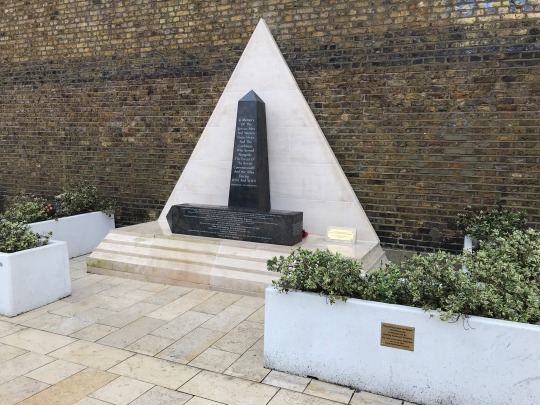

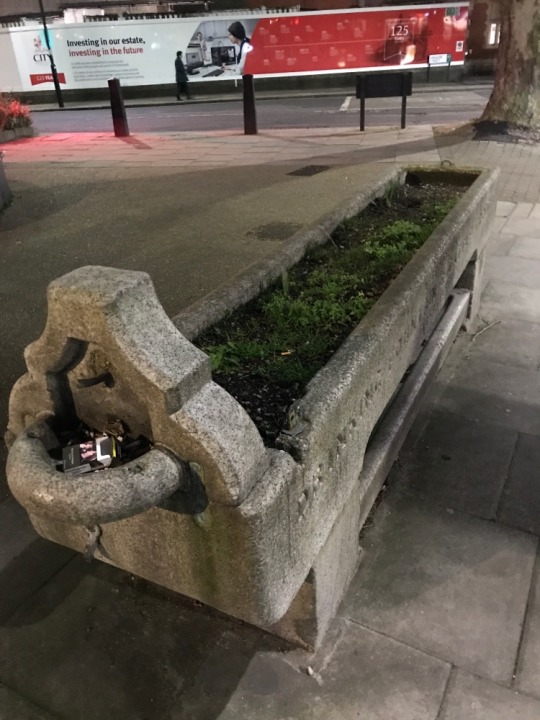
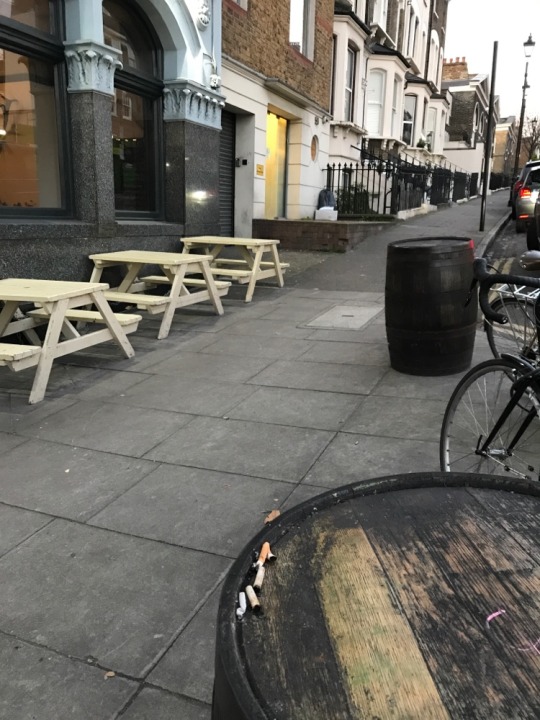


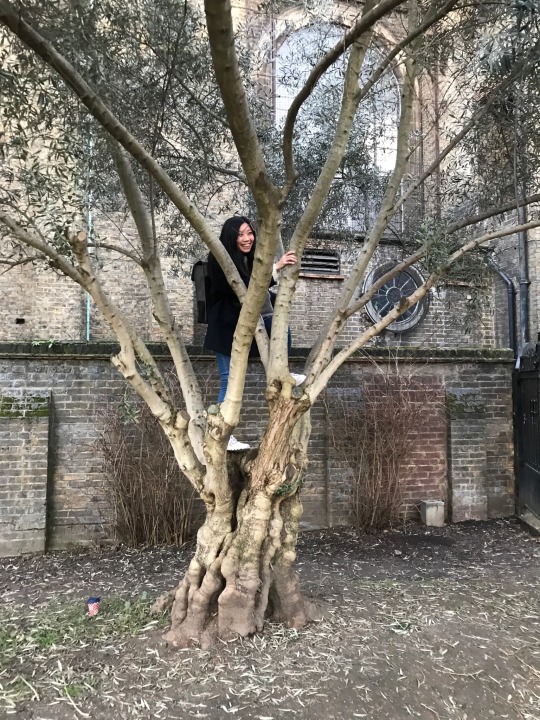

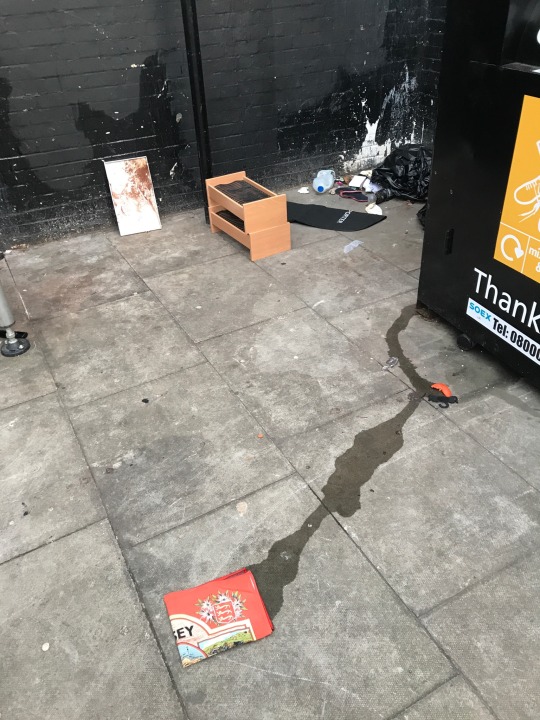
Exploring the city through photographs.
1. This is Brixton Library. The building is now used as a library, working space, source of support for the community, and it was originally donated or funded by Mr. Henry Tate, Baronet. Interesting to think about who is recorded. All the buildings must have histories, but not everyone has a statue anyway.
2,3. This is a war memorial across the street from Brixton Library, a small dignified stone obelisk under the faded imprint of a Bovril advertisement, which I would say is much less dignified. I don't know what Bovril is and I don't know these people either. They share a common space though, and it's interesting to think about how much more awareness people must have of the giant faded Bovril than the small text on the statue, which you must walk really close to see. Another instance of sharing space, repurposing space.
4. One a stone water trough (I'm guessing), it's now a planter and a holder of cigarette butts (intentional or not). Must've been important infrastructure in the past. Repurposed. Also trash, implying depending on someone else to come along and clean it.
5. Barrels outside pubs, which I see a lot in London. They're used for tables, gathering areas, and apparently ashtrays too. Outside of this setting, I don't see barrels anymore. Nobody seems to use them as their original purpose, containing. But this life seems to suit them just fine?
6. I think this is a box to house gas meters or electrical infrastructure or something of the sort, but I am not sure. The pattern of the warping/coloring on the three pasted papers are interesting, and I guess it's being used in a way as a billboard (and a trash can). Why do people throw trash into everything?? It doesn't even look like a trash can.
7. We've talked a lot about the London phone booths. Shady advertisements, sometimes dumping grounds, WiFi centers, other things. Gemma said that she still smelled it when she came out of the box. I wonder if they can be remade into real public toilets, though upkeep would be a nightmare.
8. Tree, as playground, oxygen generator, decoration, and living being.
9,10. The dumpster area here is atrocious, with mystery liquid and lots of random trash that someone hasn't bothered to put into the proper bin. I'm surprised by the ewaste recycling area, since it's such a chore in NYC (specific collection points, specific days), but who knows if this added convenience even encourages more recycling or not. After all, the trash is just strewn everywhere. Maybe I would have had the urge to pick something up from here but the mystery stains are so off putting. Why is this area so gross??? I wonder if it would change behavior to have a more posh space.
Re:recycling, it reminds me of the new law in Shanghai where you have to separate your trash and recycling more than ever before, and people were struggling. Apparently there were also bins with facial recognition now: https://www.abacusnews.com/digital-life/why-china-using-facial-recognition-garbage-bins/article/3021110
0 notes
Text
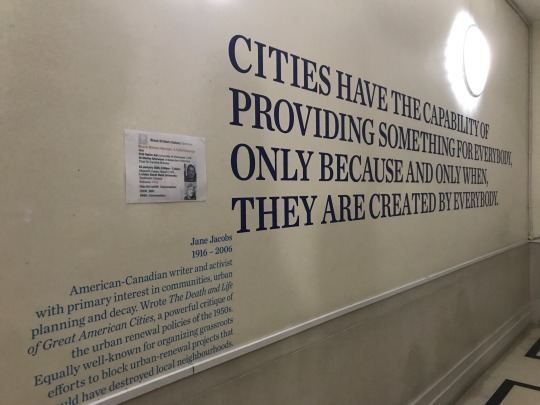
Photo text: "Cities have the capability of providing something for everybody, only because and only when, they are created by everybody."
"- Jane Jacobs 1916-2006, American-Canadian writer and activist with primary interest in communities, urban planning and decay. Wrote The Death and Life of Great American Cities, a powerful critique of the urban renewal policies of the 1950s. Equally well-know for organizing grassroots efforts to block urban renewal projects that would have destroyed local neighborhoods. "
I never got around to reading Jane Jacobs, though I've skimmed enough references to her to appreciate her view of the local community as the interactions (and potential for interactions) amongst neighbors. While Le Corbusier was in favor of making the city into big towering apartment blocks that could provide as much housing as possible with limited shared amenities, it seems like her definition of the community unit was a lot more in line with how real life shakes down.
Friday's class mentioned going into history to find inspiration for the future, in a way anyway, so it strikes me that the present complications about "smart city" echo the old question of how do you build a city for the people? How can we design for inhabitants in a way that uses citizens beyond strings of data or bodies to be stored? Maybe I should do a bit of sparknotes research into Jane Jacobs's theories and how she conceptualized community interactions. We were talking about the circular economy and it reminds me of my own experiences with feeling like being part of a community. For example:
When I was living in New York, I really loved keeping an eye out for furniture in the piles of trash outside homes the night before Trash Day. (Rarely did I ever take anything home, since the threat of bed bugs is omnipresent.) But one night, I saw a perfect frosted glass door lying on the sidewalk amongst pieces of what looked like a dismantled down IKEA wardrobe. It was about 90 inches tall, taller than my apartment ceiling, and the length of my arm.
Greed gripped me and quickly I went home and got one of my roommates to help me carry this huge glass door home. I was worried that taking it would ruin someone else's future wardrobe set, but I also really wanted to use it for projection or puppetry or art or something. I was also worried that since it was such a perfect glass door, I should be paying someone for the honor of taking it from their trash, so I wanted to escape with it quickly.
While we were trying to maneuver the door out of the pile of trash, an older woman had come out from the apartment building and watched us struggle. For some reason, my nervousness about stealing this glass door made me think it belonged to her--and maybe it did, since she noticed me nervously looking at her and went "take it!"
"It's such a nice door! Thank you so much!" I was incoherent with gratitude. I had never seen this woman in my life but I really wanted to be neighbors with her in that moment, share our lives, form a community, repay her for this boon. My roommate and I made off with the door and I never saw this woman again. The door sat in our living room, propped against the wall, unused for another two years.
When it came time to move out, I was trying to freecycle all my stuff and for some reason, I put the door up too. Who'd want a random glass door? But it was perfect and I really, really wanted to hold onto it but there was no way I could throw it back onto the street and not a chance I could take it with me.
It was the first thing to claimed. The person didn't mention why they wanted it, so my roommates and I made up many scenarios, all of them possible and ridiculous.
I got a roommate to haul it downstairs with me, and when the time came a young woman hopped out of a SUV. We struggled getting the door into her car. I managed to ask her why she wanted it. Turns out this door would become a whiteboard for her young students to draw on. What a good reason! Ultimately we managed to balance it precariously over her passenger side seats and it barely fit, but she slammed her trunk and drove away.
And so I said goodbye to the glass door, which is now hopefully living a good third(?) life.
I think this whole process was hilarious but also I love this memory because it's so rare. What if this whole process was ordinary? What if we naturally expected our items to transform, and to change ownership?
There was a great car ad a few years ago when the owner of the car asks a nosy stranger, "who are you?" "I'm the next owner," the stranger replies.
What if we talked about product lifecycles like life stories? Things would be much less disposable, surely, and maybe there would also be stronger community ties. Freecycle was good, I enjoyed the brief moment of intersection I had with this teacher, but what if I could call her up and ask her how it went? How my dear trash door is doing? What if the door could talk back to me?
What if I could call up the lady I had taken this door from, and let her know that I've also paid it forward? What if I could take more trash off the street and know that it's not infested with bed bugs, have guarantees and accountability? I really love it when I see trash that have a small message taped on: I work!
Again, this interest in histories and artifacts could be interesting if the stories were told from the voice of the object. (Would objects have an objective voice?) At the very least, I would be interested in a world where their possessors could talk to each other, trace the intersections of their lives.
0 notes
Link
When we think about caring for our neighbors, we think about local churches, and charities—systems embedded in our communities. But I see these technological systems as one of the main ways that we take care of each other at scale. It’s how Americans care for all three hundred million of our neighbors, rich or poor, spread over four million square miles, embedded in global supply chains.
I feel like I’m becoming more and more aware of the downsides of public infrastructure (failures of the FDA, roll-backs from the EPA) but maybe I should also simply meditate on the ways that I’m grateful for modern day systems...
Recently I’ve noticed more of the Link kiosks popping up around London. In NYC, they were beginning to be rolled out within the last three years. People are able to charge their electronics there, surf the internet, and it’s also used sometimes as a platform for public art (which is one of the things near and dear to my heart). The most notable thing I remember about them, however, is the articles about homeless folks using them to surf the web for porn.
On one hand, it’s not something I would want to come across in a public space. On the other, when you stop having a private space, you have to claim a bit of the public space as your own. Regular society rejects you and you become invisible, fall into the cracks a bit (or is it the other way around? thinking about that man shaving on the Amtrak train and flicking his shaving foam onto the floor, not knowing what he was doing was a public nuisance)... and I’m not sure what I’m trying to say here except express a bit of “maybe it’s kind of understandable.”
It seems like such a good idea to have internet made available for anyone to use. Invisible system ubiquitous to my 21st century big city life. Need the internet to communicate, need it to stay connected to the world, need it to... watch porn? The next step seems to be public networks, internet like sewage, though we’ll have to figure out the rules around that too,
Though at the same time, is it a real necessity? I’m experimenting this year with not having data on my phone, and it’s made me grateful but also so aware that being connected to the internet constantly isn’t wholly necessary.
(Plumbing isn’t universal the world over, so when does something become necessary? When does internet become necessary?)
0 notes
Link
Thinking about the different ways that people experience cities reminded me of a storytelling game my friends liked to play, called The Quiet Year.
Players take turns mapping the landscape and the members of a post-apocalyptic community, their struggles, their beliefs, etc. As the game progresses, players also have to take on the voices of different factions of the community and debate with each other about how conflicts and threats should be addressed.
Some games that I’ve been a part of have gotten out of hand (false prophets, sea of wolf urine, sacrificing the elderly) but I think if we reframed the game into building a city (and not a post-apocalyptic colony) the questions would be helpful for exploring what we find interesting about cities.
2 notes
·
View notes
